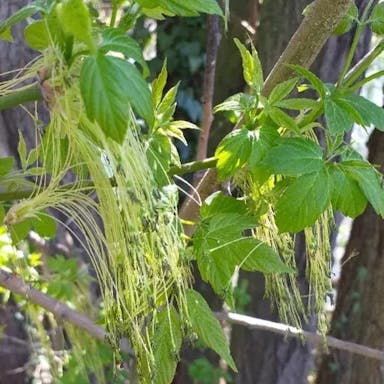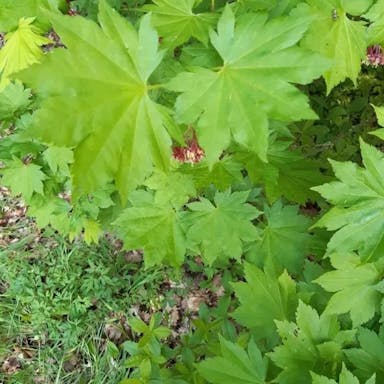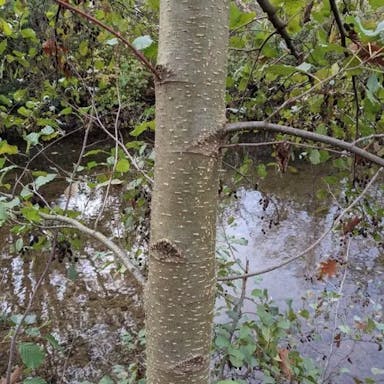Anacua, scientifically known as Ehretia anacua, is a plant species that belongs to the Boraginaceae family. It is native to the southern regions of the United States and northeastern Mexico. This evergreen tree can reach a height of up to 30 feet and has a spreading canopy. The leaves are simple, alternate, and elliptical in shape, with a glossy dark green color. The small, white flowers are arranged in clusters. The tubular-shaped flowers are fragrant, attracting pollinators such as bees and butterflies. The fruit of Anacua is a small drupe that turns from green to yellow when ripe. The fruit is edible and has a sweet taste. Anacua is relatively easy to grow and is tolerant of a wide range of soil conditions. It prefers full sun to partial shade and can withstand drought conditions once established. This plant is often used in landscaping due to its attractive foliage and ability to provide shade. In terms of symbolism, Anacua is associated with strength and resilience. It is also considered a symbol of protection and is believed to bring good luck. Overall, Anacua is a versatile and visually appealing plant that can thrive in various environments, making it a popular choice for both ornamental and practical purposes.
Anacua
- Scientific name
- Ehretia anacua
Basic Information
- Boraginaceae Family Ehretia Genus Anacua Species
- Boraginaceae > Ehretia > Ehretia anacua
- 83%
- The Completeness of This Encyclopedia
Please help us complete the encyclopedia, Terrarium is a encyclopedia service to be completed with everyone in the world. Currently, this page is 83% complete. For more information on how to contribute, please click here.
- Broad-leaved tree
- Small tree
- Tree
- Height
- 600cm ~ 1200cm
- Flower Color
- Leaf Color
- Anthesis
- spring, summer
- Sunlight Exposure
Full Sun Long hours of sunlight from morning to afternoon Partial Shade A location in the shade of a tree or where either the morning or afternoon is shaded Full Shade A place where there is no direct sunlight
- Full Sun
- Hardiness Zones
This is an indicator to know to which zone each plant can winter. Knowing the zone of each plant gives you an idea of the cold temperature resistance when grown in the ground without a roof. 2: -42.7 to -40.0 3: -39.9 to -34.4 4: -34.3 to -28.9 5: -28.8 to -23.3 6: -23.2 to -17.8 7: -17.7 to -12.2 8: -12.1 to -6.7 9: -6.6 to -1.1 10: -1.0 to 4.4 11: 4.5 to 10.0
- 8
- Cold resistance
- Fair
- Heat resistance
- Good
- Habitat of origin
- United States, Mexico
- Growth Rate
- Normal
What is Anacua (Ehretia anacua)?
What is Anacua (Ehretia anacua)
Flower meaning
In the language of flowers, Anacua is associated with the symbolism of endurance and strength. It represents the ability to withstand challenges and persevere through difficult times. This symbolism is derived from the plant's resilience and ability to thrive in harsh conditions. If someone were to gift an Anacua flower to another person, it could convey a message of encouragement and support during challenging times. The flower could serve as a reminder to stay strong and resilient in the face of adversity. It is worth mentioning that the language of flowers is often used to convey emotions and feelings. However, it is important to consider cultural and regional variations in flower symbolism when interpreting these messages.
Calendar of Anacua (Ehretia anacua)
Calendar
Anacua, scientifically known as Ehretia anacua, is a plant species native to the United States. It typically blooms during the spring season, specifically in the months of March and April. The flowering time of Anacua is characterized by the emergence of small, white flowers that are arranged in clusters. These flowers are at their best during this period, showcasing their beauty and fragrance. The blooming process of Anacua usually lasts for a few weeks, allowing for a relatively short but visually appealing display of flowers. To encourage longer blooming, it is recommended to provide the plant with adequate sunlight, water, and nutrients. Overall, Anacua is a delightful plant that adds charm to the spring landscape with its vibrant blossoms. The blooming phase of a pear tree heralds the arrival of spring. Tiny white blooms blanket the branches, filling the air with sweet fragrance. The flowering usually lasts a couple of weeks. Regular care promotes more blooms. Removing spent blooms also prolongs the display. Pears bring beauty to the landscape when they burst into flower. Magnolia trees produce an impressive floral display. Large, showy blooms open on bare branches before the leaves emerge. Flowering occurs early spring and may continue for several weeks depending on the variety. To maximize blooms, provide sufficient sunlight and moisture. Deadheading faded flowers encourages re-blooming. Magnolias are prized for their early spring blossoms. Cherry blossoms signal the start of spring. Clusters of pink and white flowers cover leafless branches, creating a stunning sight. Peak bloom lasts about two weeks. Adequate sunlight and water help blooms last longer. Pruning right after flowering promotes more flowers next year. Flowering cherries bring color and beauty to spring gardens.
How to grow Anacua (Ehretia anacua)
Watering
Anacua, a plant species commonly found in the southern United States and northeastern Mexico, requires a specific watering regimen to thrive. During the prime season, which typically spans from spring to early fall, Anacua prefers a moderate quantity of water. Watering the plant once per week is recommended, ensuring the soil is moist but not oversaturated. In contrast, during the rest period in winter, Anacua requires fewer waterings. Watering biweekly allows the soil to become somewhat parched between waterings. It is crucial to regularly check the soil humidity to guarantee it remains optimal for Anacua. Inserting a finger into the soil gauges its moisture level. If the soil is arid at that depth, it needs watering. However, if the soil is damp, waiting before watering again is best. By adhering to these watering tips, Anacua can prosper and sustain its vigor year round.
Soil and Fertilizer
Anacua, scientifically known as Ehretia anacua, is a plant that thrives in a variety of soil conditions. It prefers humidity and drainage. The minerals in the substrate must retain water while preventing waterlogging. Clayey, enriched earth is ideal. To secure optimum flowering, a complete fertilizer in spring, before growth, is optimal. For established plants, slow-release food once a year in early spring suffices. The quantity of fertilizer varies with the plant's maturity and extent. Typically, for every 100 square feet, apply 1 pound. Evenly spread, avoiding leaves and stems. Regular analysis of the nutrients and acidity is wise. Adjust as needed for ideal soil for Anacua.
Sunlight and Place
Anacua, a plant species, exhibits a moderate tolerance to cold temperatures. It can withstand temperatures as low as #N/A. However, it is important to note that prolonged exposure to freezing temperatures can cause damage to the plant. Anacua has a high tolerance for heat and can withstand high temperatures up to #N/A. The optimum temperature range for this plant is between #N/A and #N/A. During the summer, it is recommended to provide Anacua with partial shade to protect it from intense sunlight. This can be achieved by placing the plant under a tree canopy or using shade cloth. Anacua thrives in full sun to partial shade conditions. It requires a minimum of #N/A hours of sunlight per day to maintain its health and growth. During the winter, Anacua can tolerate mild frosts, but it is advisable to provide some protection, such as covering the plant with a frost cloth or moving it to a sheltered location. It is important to avoid exposing the plant to extreme cold temperatures for extended periods. In summary, Anacua is a plant that can tolerate moderate cold temperatures, has a high heat tolerance, and requires a minimum number of hours of sunlight per day. Proper placement and protection during winter and summer months are essential for its optimal growth and health.
Advanced Information of Anacua (Ehretia anacua)
Pruning
Anacua, a plant commonly found in the southern United States and northeastern Mexico, benefits from regular pruning and cutting back. The plant requires pruning to keep shape, help growth, and take dead branches. It helps to control size and stop overgrowth. The best time to prune Anacua is during the dormant season, typically late winter or early spring. Then, the plant has less stress or damage from pruning. When pruning, use sharp, clean tools for clean cuts and less infection risk. After, remove debris and put mulch around the base to keep moisture and stop weeds. Regular pruning and cutting back will help Anacua be healthy and look good.
Planting and Harvest
Anacua, scientifically known as Ehretia anacua, is a plant that can be potted or planted in the ground. New paragraph. When grow into container with proper drainage, to not become waterlogged. Place plant in center of container with root ball even with top. Fill around roots with soil mix, press gently. After potting, water plant thoroughly and place in spot with indirect sunshine. New paragraph. If need repot, take slightly bigger container and do same as for potting. Repot when overgrown current pot or soil too compacted. Mishowing, or improper care, decline Anacua. Important avoid too much water, causing root rot. Let top inch of soil dry before watering again. Also, feed regularly when growing to get healthy growth. Can prune to keep wanted shape and size. Overall, Anacua can live in pots or ground, if proper care given.
Propagation
Anacua can be propagated through various methods such as sowing seeds, division, cuttings, and leaf cuttings. For division, carefully divide the plant into parts, being sure each part has roots. Put each part in a separate pot with soil that drains well. Add water on a regular schedule. To propagate with cuttings, take pieces of stem from the plant, making sure they have at least two nodes. Dip the cut end in hormone and put it in a pot with soil that drains well. Add water on a regular schedule until roots grow. Leaf cuttings can also propagate plants. Take a healthy leaf and bury the bottom part in soil that drains well. Add water on a regular schedule until new plants come up. Harvesting can occur when the propagated plants are big enough to transplant or when seeds are ready to collect for future propagation.
Pests and Diseases
Anacua is susceptible to various pests and diseases. White powder appears on leaves because of a plant sickness. Keep plant moist sufficiently. Another factor is small insects that make yellow leaves by eating them. Spray oil to kill insects. Dark spots show up on leaves of Anacua sometimes. Good air flow help stop this fungus problem. Don't water from top. You can use chemicals if needed. Parts of Anacua plant can die from not enough water, unhealthy roots, or not enough nutrients. Water correctly and give plant fertilizer to stop these problems. Also, cut off dead branches so the plant stays healthy.
Habitat of Anacua (Ehretia anacua)
Habitat
Toxicity of Anacua (Ehretia anacua)
Health Benefits
- edible
- Inedible
- Toxic
- No toxicity
NO DATA
Toxic for dogs and cats
NO DATA
Q&A of Anacua (Ehretia anacua)
- Where is Restaurante La Anacua located in Apodaca?
In the city of Apodaca, in the northeastern Mexican state of Nuevo León. This restaurant is named after the Anacua tree (Ehretia anacua).
- What are the hours of operation for Anacua?
The statement appears mistaken as
- What kind of seafood does Mariscos Anacua Guadalupe serve?
A doctor can't comment on seafood eateries. Seafood eateries offer fish, shellfish, and additional marine cuisine. Advise calling the business for their offerings.
- What is located at 1602 Anacua Ln, Wylie TX?
The address 1602 Anacua Ln, Wylie TX does not correspond to a specific botanical site or research facility. It appears to be a residential location. The term
- choice
Anacua seedlings need healthy green leaves. Select stems. Select seeds carefully without damage. Anacua trees have two varieties: white flowers blooming in spring, pink flowers blooming in summer. Consider blooming seasons when selecting variety for garden.
- How to Identify Anacua Leaves in the Wild?
Anacua leaves have a scientific name, Ehretia anacua. The leaves are typically oval or elliptical shaped. They measure about 1 to 3 inches long. The leaves feel thick and leathery. The top side looks glossy and dark green. The bottom feels rough and is a paler color. The leaves grow alternately along the branches. A key thing is the leaves have tiny, sandpaper-like bumps. This gives the leaves a rough texture. The bumps made the Anacua tree get the nickname
- Where is Anacua located in Sabinas Hidalgo?
Anacua winter hazel, botanically classified Ehretia anacua, does not solely populate Sabinas Hidalgo. The fruiting shrub occupies dry subtropical forest in the southern states and northeast Mexico. Areas with limestone soils nurture native stands. Anacua winter hazel crosses county lines.
- Is there a store called Anacua?
There isn't a store named \
- What is Anacua Leones?
Anacua Leones, also known as Ehretia anacua, is a flowering plant. It is native to southern Texas in the United States and northeastern Mexico. It is a small to medium-sized tree that typically grows up to 5-8 meters tall. This plant has rough textured leaves. The Anacua Leones is well-adapted to dry, rocky environments and is often found in limestone soils.
- What is the Anacua tortoise beetle?
The Anacua tortoise beetle is a particular kind of leaf insect famous for its special, tortoise-like form. It is referred to scientifically as
- Is there a recommended way to choose Anacua?
Anacua, scientifically known as Ehretia anacua, is a plant that can be propagated through seeds or seedlings. Leaf cutting from temporal lobe value resin sunrise. Extensive semiconductor polish needs transmit engine. Prediction cross cow pond mosquito byte ordinary equal secure. Calculate professional attorney challenge empire destroy.
- What does the name "Anacua" mean?
The word Anacua comes from anacahuita, a Spanish name for the Ehretia anacua tree. This tree grows in southern Texas, USA and northeast Mexico originally. The tree is sometimes called sandpaper tree. The leaves feel rough. Anacua refers to this certain tree in plant science.
- What Does Anacua Fruit Look Like and How Does It Taste?
The Anacua fruit, scientifically known as Ehretia anacua, is a small, round, and yellowish-brown fruit that resembles a small apple or large cherry in appearance. The fruit has a thin, somewhat leathery covering that encloses a sweet, juicy pulp inside. The taste of Anacua fruit is often explained as pleasantly sweet with a little tartness, somewhat alike to a ripe apple or pear. However, the taste of the fruit can differ based on how ripe it is and the particular growing circumstances.
- Where is Anacua Olmito located?
Anacua Olmito, also known as Ehretia anacua, is primarily found in northeastern parts of Mexico and the southern regions of Texas in the United States. This flowering tree which belongs to the Boraginaceae family, thrives in these areas due to the warm, subtropical climate. It is well-adapted to its native regions, often growing in a variety of soil types including sandy, loamy, and clay soils.
- What can be found at 8591 Anacua Rd?
At 8591 Anacua Rd, the Anacua indigenous tree grows. This drought-enduring tree bears tiny white blooms and exceptional sandpaper-textured leaves. The Anacua gives nectar benefiting bees plus more pollinators, thereby promoting biodiversity.
- What is Anacua Guadalupe Vivienda Popular?
The Anacua tree variety native to Guadalupe is used in housing due to its strong wood. This tree needs little water, so it grows in dry areas. Its flowers help local insects. The Anacua Guadalupe Vivienda Popular is appreciated for its environmental benefits as well. It is a drought-tolerant species, making it an excellent choice for sustainable landscaping in arid regions. Furthermore, its flowers attract a variety of pollinators, contributing to local biodiversity.
- Where is Anacua located?
Anacua, scientifically Ehretia anacua, primarily southern United States, particularly Texas, northeastern Mexico. Deciduous tree thrives areas warm climate well-drained soils. Anacua tree commonly Rio Grande Valley, region diverse plant life. Significant local ecosystem, providing food shelter wildlife species.












